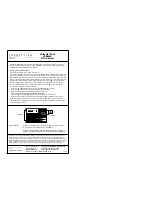
AC4868 868 MHz Transceiver
User’s Manual
Americas: +1-800-492-2320 Option 3
9
Laird Technologies
Europe: +44-1628-858-940
Hong Kong: +852 2923 0610
www.lairdtech.com/ramp
T
HEORY OF
O
PERATION
RF Architecture
The AC4868-250 is a single channel radio transceiver. Each unit can be configured as a Server or as a Client.
Servers are responsible for sending out beacons and for allow for radios to be configured very simply in a
point-to-multipoint network. Servers are not required for operation, but if they are used, there should only be
one Server per network. All other radios in the network should be configured as Clients. Clients can
communicate point-to-point or in a mesh with or without a Server.
Modes of Operation
The AC4868-250 has three different operating modes; Receive, Transmit, & Command Mode. If the
transceiver is not communicating with another radio, it will be in Receive Mode actively listening for a beacon
from the Server. If the Client determines that the beacon is from a server operating on the same RF Channel
and System ID, it will respond by asserting In_Range Low. A transceiver will enter Transmit or Command mode
when the OEM Host sends data over the serial interface. The state of the Command/Data pin (Pin 17) or the
data contents determine which of the two modes will be entered.
Transmit Mode
All packets sent over the RF are either Addressed or Broadcast packets. Broadcast and Addressed delivery can
be controlled dynamically with the API Control byte and corresponding on-the-fly commands. To prohibit
transceivers from receiving broadcast packets, Unicast only can be enabled.
Addressed Packets
When sending an addressed packet, the RF packet is sent only to the receiver specified in destination address.
To increase the odds of successful delivery, Transmit retries are utilized. transparent to the OEM Host; the
sending radio will send the RF packet to the intended receiver. If the receiver receives the packet free of errors,
it will return an RF acknowledge within the same 53 ms hop. If a receive acknowledgement is not received, the
radio will use a transmit retry to resend the packet. The radio will continue sending the packet until either (1)
an acknowledgement is received or (2) all transmit retries have been used. The received packet will only be
sent to the OEM Host if and when it is received free of errors.
Broadcast Packets
When sending a broadcast packet, the RF packet is sent out to every eligible transceiver on the network. To
increase the odds of successful delivery, Broadcast attempts are utilized. Transparent to the OEM Host, the
sending radio will send the RF packet to the intended receiver(s). Unlike transmit retries, all broadcast attempts
are used; regardless of when the RF packet is actually received and without RF acknowledgements. If the
packet is received on the first attempt, the receiver will ignore the remaining broadcast attempts. The received
packet will only be sent to the OEM Host if and when it is received free of errors.
Receive Mode
When a transceiver is not in Transmit or Command mode, it will be in Receive Mode listening for data. While
in Receive Mode, subsequent data of up to 80 bytes can be received every hop (53 ms).
Command Mode
A radio will enter Command Mode when data is received over the serial interface from the OEM Host and
either the Command/Data pin (pin 17) is logic Low or the received data contains the “AT+++” (Enter AT










































